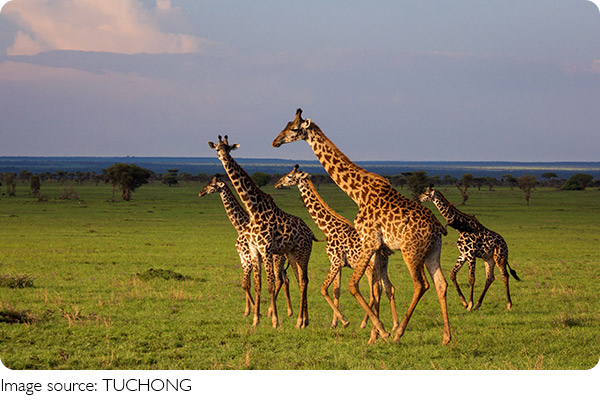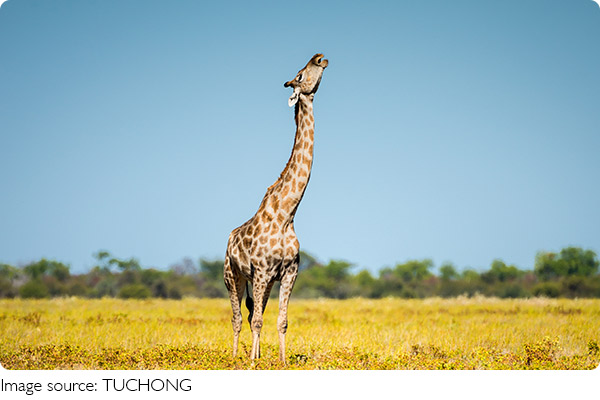Giraffe Neck Mystery

When we picture a giraffe, the first thing that stands out is its long neck. It's their signature feature, making them the tallest land animals on Earth. But have you ever wondered why giraffes have such long necks?
It turns out the answer is more complex—and more fascinating—than just "reaching high leaves."
Giraffe Neck Mystery
Video by PBS Eons
Reaching the Top of the Tree
The most common explanation is about food. In the African savannas where giraffes live, trees like acacias grow tall. By having long necks, giraffes can reach leaves that other animals can't. This gives them access to food with less competition. While antelopes and zebras graze below, giraffes can enjoy leafy snacks from the treetops.
But here's the twist: giraffes actually spend a lot of time feeding at shoulder level, not always way up high. So there has to be more to the story.
The Battle for Mates
Another major theory is about competition—not for food, but for love. Male giraffes often fight each other by swinging their necks and heads like hammers. This behavior is called necking. The one with the longer and stronger neck usually wins the battle—and the right to mate.
Over time, natural selection may have favored giraffes with longer necks because they had better chances of reproducing. This idea is known as mate selection, and it's a powerful force in evolution.
What's Inside That Neck?
Here's a fun fact: giraffes, like humans, have only seven neck vertebrae (neck bones). Each one is just much longer than ours—up to 10 inches each! These long bones, along with strong muscles and flexible joints, make their necks both sturdy and graceful.
To support that long neck, giraffes also have an extra-large heart—about 11 kilograms (25 pounds)—to pump blood all the way to the brain. Their blood pressure is also among the highest in the animal kingdom.
Giraffes and Gravity
With such long necks, giraffes face a unique challenge: gravity. When they lower their heads to drink water, the sudden change in blood flow could be dangerous. Luckily, giraffes have a special system of valves in their neck veins to control blood pressure and prevent fainting.
Their bodies are like finely tuned machines, adapted over millions of years to balance height, circulation, and movement.
It's Not Just the Neck
Long legs play a big part, too. Giraffes' legs are almost as long as their necks, helping them move across large distances and run at speeds of up to 60 km/h (37 mph) when needed. The combination of long legs and neck gives them their iconic tall and elegant silhouette.
Still Some Mysteries Left
Even though scientists have strong theories, we still don't know everything about why giraffe necks evolved the way they did. Some researchers think there could be a mix of reasons—feeding advantages, mate competition, and even better vision over tall grass to spot predators.
Nature often works through many small steps, not just one big reason.

Let's Keep Wondering
The giraffe's long neck is more than just a funny feature—it's a result of millions of years of adaptation. Whether it's for survival, love, or both, this unique trait shows how amazing evolution can be.
Have you ever seen a giraffe up close? What surprised you the most—the height, the way they move, or how gently they nibble leaves? Let's share what we've learned and keep exploring the wonders of wildlife together!
-
 Rise of RobotsAre Robots Stealing Our Jobs or Saving Us Time? The Answer Will Surprise You!
Rise of RobotsAre Robots Stealing Our Jobs or Saving Us Time? The Answer Will Surprise You! -
 Speed Redefined SupercarsTop 9 Supercars That Defy Physics with Insane Power-to-Weight Ratios!
Speed Redefined SupercarsTop 9 Supercars That Defy Physics with Insane Power-to-Weight Ratios! -
 Xeroderma PigmentosumCan DNA Repair Break Down From Sunlight?! Shocking Truth Behind Xeroderma Pigmentosum Unveiled!
Xeroderma PigmentosumCan DNA Repair Break Down From Sunlight?! Shocking Truth Behind Xeroderma Pigmentosum Unveiled!